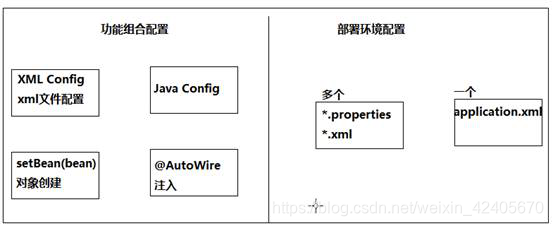面试题: SpringBoot 的自启动原理
个人博客网:https://wushaopei.github.io/ (你想要这里多有)
引言
不论在工作中,亦或是求职面试,Spring Boot 已经成为我们必知必会的技能项。除了比较老旧的政府项目或金融项目依旧使用如 SSM 或 SSH 做单体框架开发项目外,如今的各行各业基于项目的快速开发与发布、迭代更新,都在逐渐替换使用 Spring Boot 框架,而逐步摒弃配置沉重和效率低下的 Spring 启动框架。
使用一门新的技术,立足于对它足够了解的基础上,能够让你更加得心应手的去进行应用、开发。SpringBoot 的精髓 “自动配置原理” 不仅仅是在面试过程中才用的上;在工作中如果能深入理解Spring Boot 的自动配置原理,我们就可以根据自己的需求自定义一个 started 满足开发的需求,让开发更加便捷与高效。
Spring Boot的出现,得益于“习惯优于配置”的理念,没有繁琐的配置、难以集成的内容(大多数流行第三方技术都被集成),这是基于Spring 4.x提供的按条件配置Bean的能力。
本篇博文主要针对三个方面进行分析、讲解;这三个方面分别是:
- Spring Boot 与 Spring 的差别与优点?以及与Spring MVC 的关系?
- Spring Boot 主启动类的启动机制
- Spring Boot 的自动配置原理是怎么实现的?
- 根据自动配置原理自定义一个 个性的 started ?
1、Spring Boot 与 Spring 的差别与优点?以及与Spring MVC的关系?
1.1 Spring Boot 和 Spring MVC 的关系?
Spring MVC 是基于Spring 的MVC框架;
而Spring Boot 是基于Spring 配置的开发工具框架,使用注解更加简洁和适应快速开发。
1.2 Spring Boot 的优势
简单来说:Spring boot 简化了使用 Spring 的难度,简省了繁重的配置,提供了各种启动器,开发者能快速上手。
(1)编码更简单
- Spring 框架由于超重量级的 XML,annotation 配置,使得系统变得很笨重,难以维护
- SpringBoot 采用约点大于配置的方法,直接引入依赖,即可实现代码的开发
(2)配置更简单
Xml文件使用javaConfig代替,XML中bean的创建,使用@bean代替后可以直接注入。
配置文件变少很多,只保留 application.yml
(3)部署更简单
(4)监控更简单
- Spring-boot-start-actuator:
- 可以查看属性配置
- 线程工作状态
- 环境变量
- JVM性能监控
2、Spring Boot 主启动类的启动机制
关于程序的入口问题:
在使用SSM或SSH以及原生的Servlet 作为架构的项目中,项目的入口都不是 main 方法,main 方法更多的是作为 HelloWorld 练习或 测试时使用。其程序的入口基本都是handler 中对外暴露的每个接口:
外部通过对接口地址的调用,从而实现交互获取数据、进行页面渲染和展示。
但是,在使用了 Spring Boot 后, Main 方法又成为了程序的入口;
使用过springBoot进行项目打包和部署启动的都知道, SpringBoot 打包成 jar 包后,可以不需要部署到Tomcat 上而直接用命令启动,如下:
这是因为Spring Boot 的jar 在启动时,程序经过 主启动类中的main 方法进行启动的;主启动类代码如下:
在这里为项目创建一个接口,并分别在接口和主启动类main方法上打断点,
在Spring Boot 项目中每次调用接口前都会先启动 主启动类,这里对主启动类的 main 方法入口进行分析;
在上图中,主启动类启动后会进入main 方法中,并在方法中 由 SpringApplication 调用 run ()方法,方法中形参传入当前类的 class 对象以及main 方法的 args 参数。
下一步进入 run() 方法中,
由断点可以知道,在run() 方法中还调用了另一个 run( )方法,再点击进入下一步,
由截图可知,传入的class 对象被用来创建 SpringApplication实例对象,并由生成的实例调用 run (args) 方法做启动操作,方法形参为 args 参数。
①创建 SpringApplication 实例,进行初始化对象:
new SpringApplication ( Object... sources)
在 该构造函数的 方法体中,对当前类进行了初始化,
上图中的 webEnvironment 用于检测当前环境是否为 web 环境,如果是,则返回true.
具体如何判断当前环境是否为 web 环境,后面再做分析.
获取初始化器:
在确定是否为web环境后,会根据 ApplicationContextInitializer.class 获取工厂实例参数从而设置初始化器的参数;
随后 用setListeners 设置监听器
判断并获取主启动类的类型,通过获取jvm运行时的栈(StackTraceElement[])中的多个加载的类,判断类中方法是否符合 main 方法 的类即为当前启动类,
到这里,SpringApplication 的初始化过程就执行完毕了;此时的SpringApplication 实例的启动需要调用run() 方法来实现,下一节进行分析;
以下是初始化过程的重要环节的关系图:
判断当前环境是否为 web 环境:
我们进入 deduceWebEnvironment()方法去看一看,
由源码可知, deduceWebEnvironment 中对 私有变量 WEB_ENVIRONMENT_CLASSES进行了循环,继续查看它所代表的是什么?
该私有变量数组有两个参数构成,第一个参数是 “javax.servlet.Servlet”,第二个参数是 “ConfigurableWebApplicationContext”,这里对“ConfigurableWebApplicationContext”进行分析:
进入ConfigurableWebApplicationContext类中,我们看到该类继承自 WebApplicationContext 和 ConfigurableApplicationContext两个类,再往下看:
我们看到 WebApplicationContext 继承自 ApplicationContext 类,而我们知道 ApplicationContext 是可以用来创建IOC 容器的对象的,如:
该ApplicationContext类是所有IOC 容器对象的顶级接口
阶段小结:ConfigurableWebApplicationContext 是 web 环境下可以配置的IOC 容器。
那么拿到该类的全类名有什么用呢?
在 deduceWebEnvironment 方法中调用了 isPresent 方法,而在isPresent方法中有调用 forName ,将全类名 className 作为形参传入 forName中,此处的 classLoader 是null值。
这里进入 ClassUtils的forName()方法中,代码如下:
其中的 Class<?> clazz = resolvePrimitiveClassName(name); 根据全类名获取class 字节码文件对象;在获取到的class 对象不为null 的情况下,clazz = (Class)commonClassCache.get(name); 获取常用类缓存中是否也存在该class对象;
如果两次获取的 clazz 都不为null是存在的,那么就直接返回:
由此我们可以知道,isPresent()方法的作用,是为了查看当前环境中有没有指定的工程项目的类。
从这里,我们可以做出总结,deduceWebEnvironment () 方法中通过判断 “WEB_ENVIRONMENT_CLASSES”数组中声明的两个类能否在当前环境中找到,如果能,说明当前环境为web 环境。
② SpringApplication实例的启动过程:
在获取到SpringApplication的实例并初始化完成后,其启动使用run() 方法实现,
进入 run(args)方法中,
这里先从 stopWatch 开始说,在run() 方法中,一开始创建了 StopWatch的对象实例,并调用 start() 进行启动,
这里的 stopWatch 是一个观察用的表,springboot项目启动后返回的启动花费了多少秒、分的时间就是由 stopWatch() 来提供的。
总结: 在public ConfigurableApplicationContext run(String... args)方法中,最终返回的是自定义配置的IOC容器。
到这里,SpringBoot 的主启动类 Main 方法的初始化和启动过程就结束了。
③ 包扫描;
我们知道 Spring 中IOC通过 依赖注入和控制反转将被调用者Bean的创建交给Spring 代理生成,并注入到IOC容器中;而在SpringBoot中, 接口的调用必须基于SpringBoot 主启动类的同级包或子包范围内;
规范化的开发中需要指定好 Handler 和 dao 层的包位置,分别指定的包扫描方式为:
控制器与业务层 :
自动扫描: 主要针对 @Controller、@Service 标注的类,该类所在包必须为主启动类所在包的子包;
手动指定扫描:在主启动类上使用@CompomentScan(“com.mmall.handler”) 注解
持久层:
方式一:使用@MapperScan
方式二: 使用@Mapper




















【推荐】国内首个AI IDE,深度理解中文开发场景,立即下载体验Trae
【推荐】编程新体验,更懂你的AI,立即体验豆包MarsCode编程助手
【推荐】抖音旗下AI助手豆包,你的智能百科全书,全免费不限次数
【推荐】轻量又高性能的 SSH 工具 IShell:AI 加持,快人一步
· 开发者必知的日志记录最佳实践
· SQL Server 2025 AI相关能力初探
· Linux系列:如何用 C#调用 C方法造成内存泄露
· AI与.NET技术实操系列(二):开始使用ML.NET
· 记一次.NET内存居高不下排查解决与启示
· 被坑几百块钱后,我竟然真的恢复了删除的微信聊天记录!
· 没有Manus邀请码?试试免邀请码的MGX或者开源的OpenManus吧
· 【自荐】一款简洁、开源的在线白板工具 Drawnix
· 园子的第一款AI主题卫衣上架——"HELLO! HOW CAN I ASSIST YOU TODAY
· Docker 太简单,K8s 太复杂?w7panel 让容器管理更轻松!